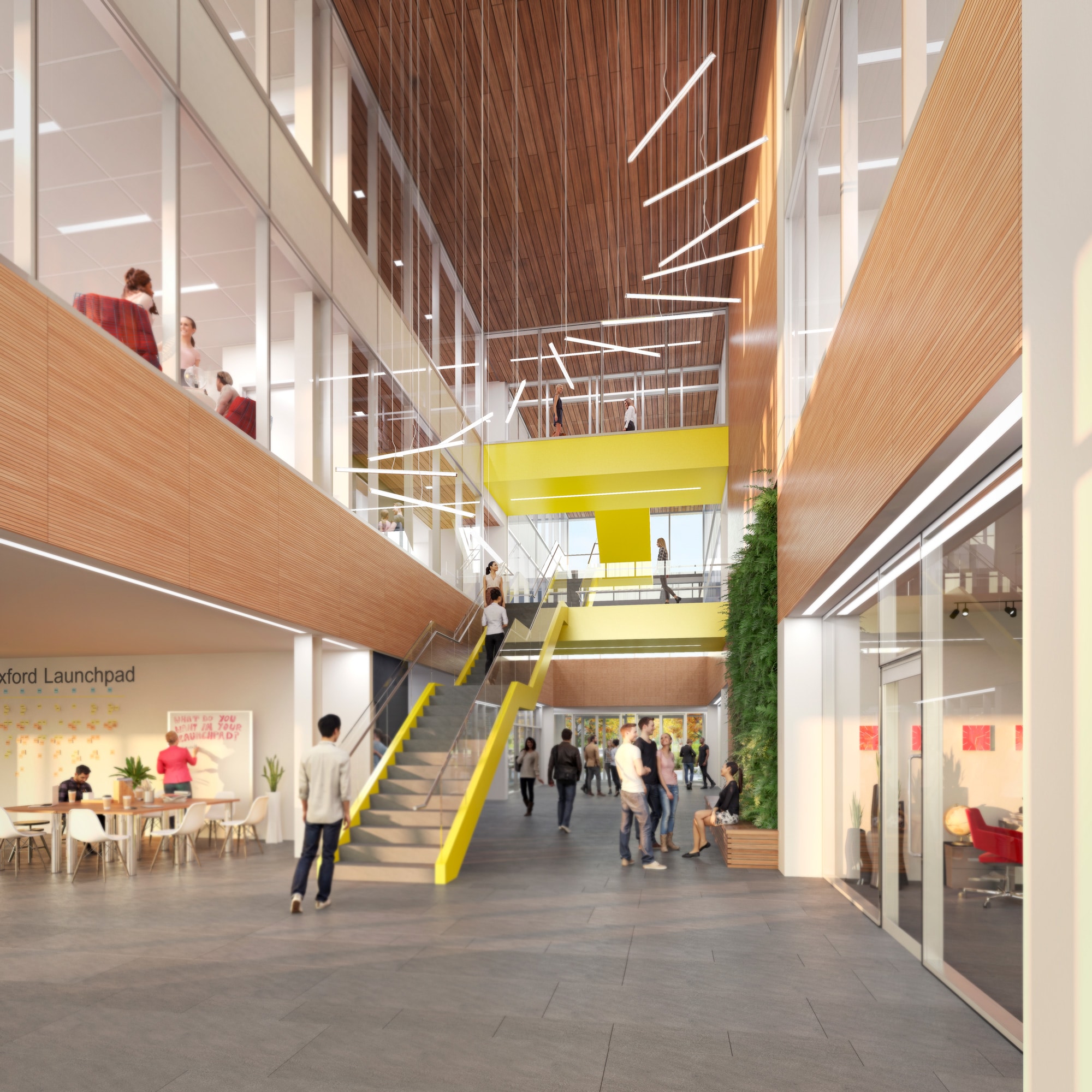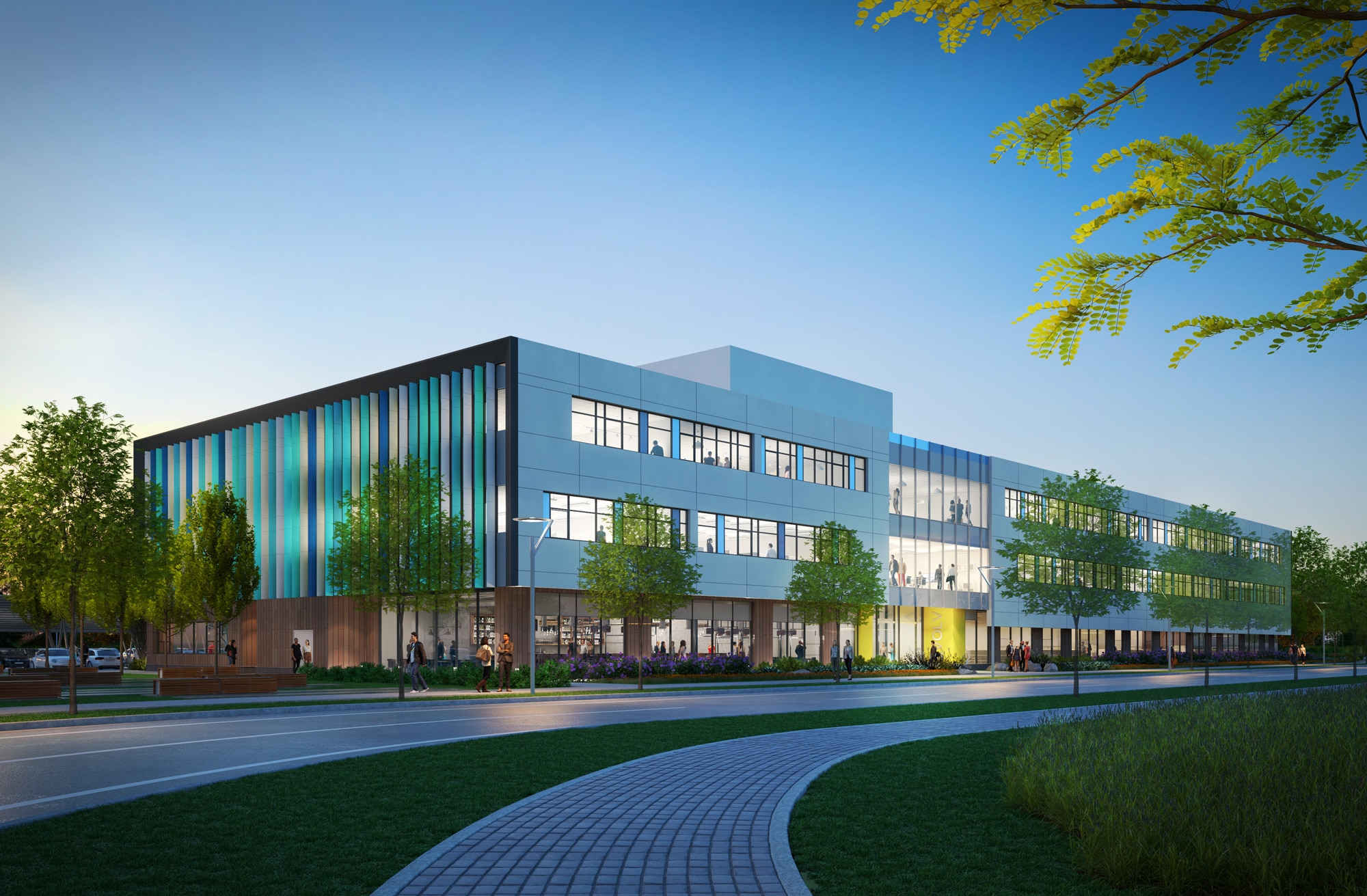
In Waterloo, evolv1 is well on its way to reaching LEED Platinum certification with its bevy of green features. [Photo: Courtesy of Stantec]
Evolv1, a modern, more-than 100,000-square-foot, Class A commercial building in Waterloo’s David Johnston Research + Technology Park in Ontario, is already making headlines—and it hasn’t even been completed. That was the intent, says Adrian Conrad, chief operating officer at The Cora Group, one of the masterminds behind this project. Together, Cora Group, Sustainable Waterloo Region, the technology park, and anchor tenant EY Canada wanted to push the conversation about sustainable development. “[We] had this collective vision to see a replicable, net-positive energy, highly sustainable building be built in the Waterloo region,” Conrad says. “We’ve got all kinds of people setting targets around the world—wouldn’t it be nice to be sustainable in 10 years or 20 years? We’re doing it next year. We are on the ground now.”
Thanks to these groups’ unique collaboration, and the efforts of consulting group Stantec, evolv1 is on track to not only meet its LEED Platinum target, but perhaps set a new standard in the sustainable building industry. It was recently chosen to be part of the CaGBC’s Zero Carbon Pilot Program, one of just 18 other buildings and one of very few core and shell commercial projects. “It has became a mission of ours at Cora Group to push the limits of sustainability,” Conrad says.

[Photo: Courtesy of Stantec]
This isn’t Cora Group’s first highly anticipated project. They have four other buildings in the park, each more sustainable than the last. This one, says Stantec’s Matt Cable, project manager during evolv1’s feasibility study, will be hard to beat, not only because of its features but also because of its practicality. “Adrian was looking to develop something really unique,” he says. “He wanted to be really forward-thinking as a developer and build something completely new, sustainable and, because he is a developer, something that has a business case for it.”
“We’ve got all kinds of people setting targets around the world—wouldn’t it be nice to be sustainable in 10 years or 20 years? We’re doing it next year. We are on the ground now.”
In order to tease out the complexities, Stantec relied on its proprietary energy modeling software to “essentially model all of the systems that you could possibly think of going into this building at the same time.” Rather than starting at the bottom and adding in pieces until they reached their sustainability goals, Cable says they took the opposite approach. “We used our energy modeling software to input all of the options, all the R-values for windows and walls, multiple electrical and mechanical systems—we put it all into the model, ran them all at the same time, and came up with a matrix of results. We were then able to backtrack and, by assigning costs, were able to find that balance of meeting the goals while making business sense.”

[Photo: Courtesy of Stantec]
The final concept includes key features like an open-well geothermal system, tied into local aquifers, that draws water into the building heat exchanger as a source for heating and cooling the building; a variable refrigerant flow system indoors; water retention, water collection, and water reuse for irrigation, which is also tied into a local bioswale; a significantly insulated and efficient structure with triple-glazed windows, solar shading, and a large solar wall designed to blend seamlessly into the side of the building; and, on the energy production side, a 700kW PV array.
And although the interior will be left to the tenants to outfit, the design team paid close attention to future inhabitants’ health with a three-story atrium, an open staircase to motivate workers to use the stairs, and a green wall to supply fresh air. Conrad also insisted on plenty of daylight. Despite the challenges of adding more windows when targeting high energy efficiency, the team was able to achieve a 40% window-to-wall ratio. Evolv1 is also located about 260 feet from a light rail transit station.
Initial construction of evolv1 began in spring 2017, and the team anticipates completion of the base shell by July 1, 2018. Conrad and The Cora Group are already planning their next headline-inspiring, sustainable structure. “This concept is already replicable,” Conrad says. “This is just evolv1—evolv2 will go in right across the road and make use of what we’ve learned.”
